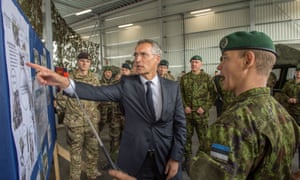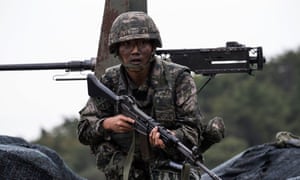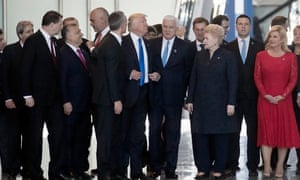Daniel Boffey
 Exclusive: Jens Stoltenberg warns of converging threats as Russia mobilises estimated 100,000 troops on EU’s borders
Exclusive: Jens Stoltenberg warns of converging threats as Russia mobilises estimated 100,000 troops on EU’s borders
The world is more dangerous today than it has been in a generation, the head of Nato has said, days before the mobilisation of an estimated 100,000 Russian troops on the EU’s eastern borders, and as a nuclear crisis grows on the Korean peninsula.
Jens Stoltenberg, secretary general of the military alliance, said the sheer number of converging threats was making the world increasingly perilous.
Asked in a Guardian interview whether he had known a more dangerous time in his 30-year career, Stoltenberg said: “It is more unpredictable, and it’s more difficult because we have so many challenges at the same time.
“We have proliferation of weapons of mass destruction in North Korea, we have terrorists, instability, and we have a more assertive Russia,” Stoltenberg said during a break from visiting British troops stationed in Estonia. “It is a more dangerous world.”
From next Thursday, over six days, Russian and Belarusian troops will take part in what is likely to be Moscow’s largest military exercise since the cold war. An estimated 100,000 soldiers, security personnel and civilian officials, will be active around the Baltic Sea, western Russia, Belarus and the Russian exclave of Kaliningrad, without the supervision required under international agreement.
On the other side of the world, in the face of local protests, the South Korean government has deployed the controversial US Thaad missile defence system as it looked to counter potential future attacks from North Korea, which recently launched a ballistic missile over Japan, threatened the US Pacific territory of Guam and tested a possible thermonuclear device.
Donald Trump has threatened to unleash “fire and fury” on the North Koreans should further threats be made against the US, and kept up the threat on Thursday, saying he is building up US military power.
“It’s been tens of billions of dollars more in investment. And each day new equipment is delivered – new and beautiful equipment, the best in the world, the best anywhere in the world, by far,” Trump said. “Hopefully we’re not going to have to use it on North Korea. If we do use it on North Korea, it will be a very sad day for North Korea.”
Trump has ruled out talks with Pyongyang for the time being and Washington’s diplomatic focus is now on efforts to secure agreement at the United Nations for much tighter economic measures, including an oil embargo and possibly a naval blockade.
 FacebookTwitterPinterest A South Korean marine participating in an exercise this week. Photograph: Handout/South Korean Defense Ministry vi
FacebookTwitterPinterest A South Korean marine participating in an exercise this week. Photograph: Handout/South Korean Defense Ministry vi
Speaking during his visit to the Estonian military base in Tapa, a former Soviet Union airstrip about 75 miles (120km) from the border with Russia, Stoltenberg was coy when asked if he backed the US president’s bellicose threats to Pyongyang, blamed by some for exacerbating the current situation in south-east Asia.
“If I started to speculate about potential military options I would only add to the uncertainty and difficulty of the situation so I think my task is not to be contribute to that. I will support efforts to find a political, negotiated solution,” he said.
Pushed on whether he could even envision a military solution to the crisis in Korea, Stoltenberg said: “I think the important thing now is to look into how we can create a situation where we can find a political solution to the crisis.
“At the same time I fully understand and support the military message that has been implemented in the region by South Korea and to some extent Japan, as they have the right to defend themselves. They have a right to respond when they see these very aggressive actions. I also support the presence of US troops and capabilities in Korea.”
Stoltenberg, a former Norwegian prime minister whose 10 years in power were marked for his success in improving Norway’s environmental footprint, took over the role of Nato secretary general in 2014, forming a close working relationship with Barack Obama.
Soon after Trump’s election last year, however, in response to suggestions that the White House might back away from Nato, Stoltenberg made a pointed intervention highlighting the lives lost by the alliance’s members coming to the aid of the US after the 9/11 attacks. Trump had described Nato as obsolete during his election campaign.
In May, Stoltenberg took on the role of placater-in-chief after the US president used the occasion of the opening of Nato’s new building in Brussels, and the unveiling of a memorial to 9/11, to castigate 23 of the 29 Nato members for not spending enough on defence. A number of leaders were visibly startled by the nature and timing of the speech.
Asked this week whether Trump was the ideal person to unpick the current fraught security situation, Stoltenberg insisted the 29 Nato members were united within the alliance. “Donald Trump is the elected president of the United States,” he said. “And Nato is a collective alliance of 29 democracies. And that’s part of democracy, that different political leaders are elected.”
 FacebookTwitterPinterest Donald Trump at the Nato headquarters in Brussels in May. He had just shoved the Montenegrin prime minister aside. Photograph: Etienne Laurent/EPA
FacebookTwitterPinterest Donald Trump at the Nato headquarters in Brussels in May. He had just shoved the Montenegrin prime minister aside. Photograph: Etienne Laurent/EPA
He said he did not believe there was an imminent threat to Nato members, and that an increase in defence spending had strengthened the alliance in recent years.
Stoltenberg has completed a tour of the four battle groups stationed in Estonia, Latvia, Lithuania and Poland, forming the Nato advanced forces defending the eastern borders.
Stoltenberg said the troops’ “defensive” mobilisation was a message to Russia that an attack on one Nato ally was an attack on all, and that he remained confident of the security of eastern Europe. But he expressed concern at Moscow’s imminent failure to live up to its international obligations for exercises involving more than 13,000 troops to be open to observers, including overflights. Some Baltic states estimate that about 100,000 Russian troops will be involved in this year’s exercise and Poland claims the Kremlin has requisitioned more than 4,000 train carriages to move military personnel west.
“Russia has said it is below 13,000. They briefed that on the Nato-Russia council a few weeks ago,” Stoltenberg said. “That was useful but at the same time we have seen when Russia says that an exercise has less than 13,000 troops that’s not always the case. We have seen that in Zapad 2009 and 2013 – the two previous Zapad exercises. There were many more troops participating.”
Stoltenberg said Nato had always offered up its exercises to scrutiny, “while Russia has not opened any exercise to open observation since the end of the cold war”.

No comments:
Post a Comment